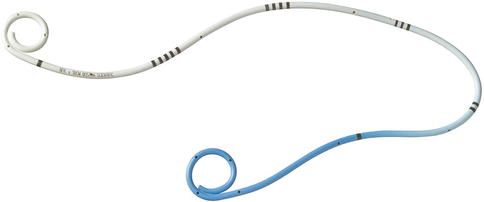Fig. 22.1
Small openings in the stent allow urine to drain in and out of the stent

Fig. 22.2
Ureteral stent demonstrating the curls on each end
Stents are designed in a variety of different materials, different rigidity, different lengths, and different diameters to provide various benefits depending on the situation. Most stents are made of a polyethylene plastic-like material, which is used for ureteral stone or stricture treatment procedures. Some stents are also made of titanium that can withstand obstruction or blockage of the ureter. These stents are used in cancer patients that may experience obstruction or blockage of the tube.
The length of the stents used in adult patients varies between 22 and 30 cm. For children and shorter patients, there are smaller length and diameter stents. These tubes are also used in transplant patients where the stent bridges a short segment of ureter connecting the transplanted kidney to the native bladder.
What Are the Advantages of Having a Ureteral Stent?
A Urologist will place a ureteral stent in a patient for several reasons. These include:
Obstruction: If there is a blockage in the ureter, called an obstruction, this may result in hydronephrosis. A ureteral stent will allow urine to flow from the kidney to the bladder even when the ureter is blocked due to a stone, ureteral stricture, etc. In this situation, the ureteral stent keeps the ureter patent and allows urine produced by the kidney to drain, avoiding potential renal damage, called acute kidney injury (AKI). Severe pain is avoided with the ureteral stent in place, as the kidney is able to drain properly.
Infection: The risk of infection in the urinary tract is reduced with the stent in place.
Injury: On occasion, there can be an injury to the ureter. This may result from blunt (motor vehicle accident) or penetrating trauma (gunshot wound). Ureteral injuries can occur due to a surgical procedure, called an iatrogenic injury during a urological procedure (i.e., ureteroscopy) or non-urological procedure (i.e., hysterectomy or colon surgery). In this situation, a ureteral stent is inserted to protect the ureter and to insure proper healing. Without the placement of a stent, a severe narrowing of the ureter, referred to as a stricture, may develop resulting in poor drainage of the kidney and possible kidney injury.
Swollen ureter: The irritation of a stone against the walls of the ureter can result in edema and narrowing of the ureter. Likewise, multiple trips with a ureteroscope to remove stone fragments, called ureteral manipulation, may result in irritation and swelling of the ureter, resulting in a smaller lumen. The presence of a ureteral stent allows the swelling to resolve and the ureter to open up to it’s normal diameter which may take up to 1–2 weeks.
Narrowed ureter: If a stone is severely obstructing the ureter or the ureter is naturally small, it may be too tight for a ureteroscope or other instruments to pass. If passing a ureteroscope is unsuccessful, a stent is placed to aid in the stretching of the ureter. This dilation may allow the stone to pass. Otherwise, the distention of the ureter over time may aid the urologist to successfully pass a ureteroscope and remove the stone during a future procedure.
Prophylaxis: A patient may undergo a stone procedure (ureteroscopy, ESWL or PCNL) where there are multiple stones in the kidney, referred to as high stone burden. During this procedure, the stone fragments that are generated can get stuck in the ureter forming a column of stones, called steinstrasse (German for street of stone). In anticipation of stone fragments resulting in steinstrasse, a stent can be placed to avoid a future obstruction.
What Are the Disadvantages of Having a Ureteral Stent?
Most patients will do fine with the inserted stent, some however, may have some symptoms related to the stent. Most individuals are able to endure the ureteral stent without any event. Some patients are unable to accept the stent. It is not possible to forecast which individuals will have side effects from the stent and those that will not. Some of the issues secondary to the stents include:
Blood: Stents can cause blood to appear in the urine intermittently or continuously. During physical exertion, the movement of the stent and rubbing of the stent against the bladder can produce blood in the urine.
Stay updated, free articles. Join our Telegram channel

Full access? Get Clinical Tree




